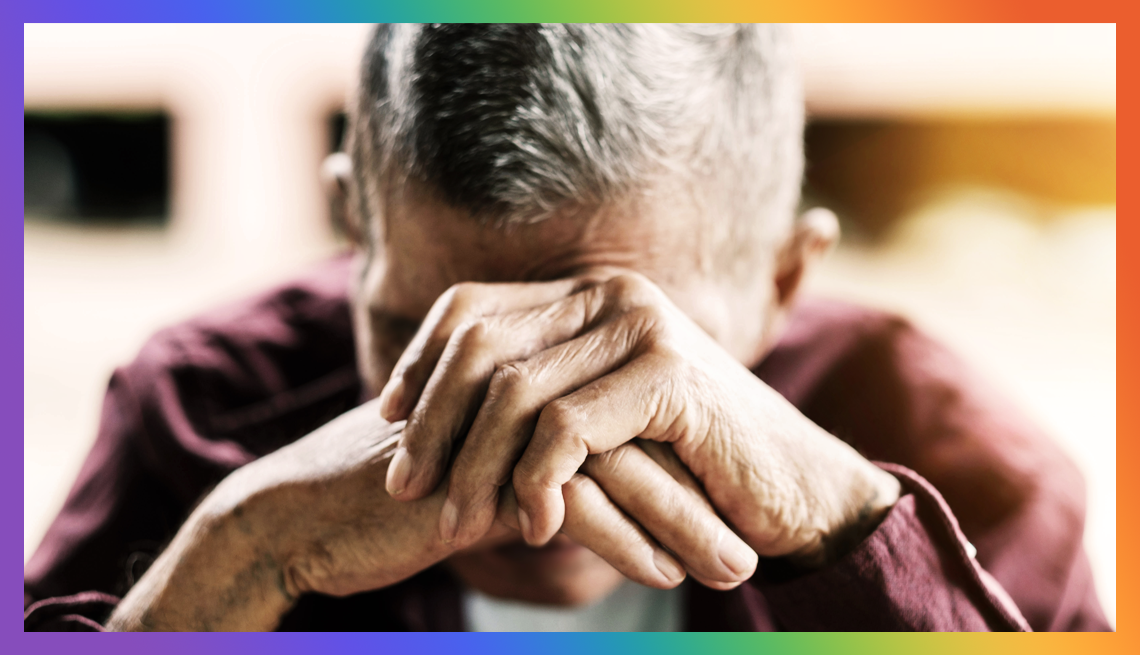AARP Hearing Center


Ron Blake doesn’t just talk about the importance of social connections — he lives it.
The 55-year-old gay artist and activist says he makes it a point to introduce himself to someone new almost every day. Blake says he believes having a close-knit group of friends is especially important for LGBTQ+ older adults, who might not have children or who could be estranged from family.
“Even if you’re married and have a spouse, if they’re your only friend and something happens to them, you could be left alone,” says Blake, who lives in Phoenix.
It’s a common worry among people in the LGBTQ+ community, according to a new AARP survey of more than 2,200 LGBTQ+ adults ages 45 and older, conducted in April.
The AARP Dignity 2024 survey found that four out of five older LGBTQ+ adults, or 78 percent, are concerned about having enough social support as they get older. Women and Black respondents, along with those who have a disability, were more likely to say they are “extremely” or “very” concerned about a lack of social support in the future.
The survey also found that half of LGBTQ+ older adults already feel socially isolated at times, which can have a profound impact on a person’s mental and physical health, research shows. The feelings are highest among transgender and nonbinary adults, with 63 percent reporting they often or sometimes feel isolated from others.
AARP published its first Dignity survey in 2018 and repeats the survey every other year. The reports offer important insights into the life experiences and concerns of older LGBTQ+ adults amid an increasing number of U.S. adults identifying as LGBTQ+, says AARP Senior Research Advisor Cassandra Cantave Burton.
About 7.6 percent of American adults identify as lesbian, gay, bisexual, transgender, queer, or another nonheterosexual orientation, according to a 2024 Gallup poll. That’s up from 5.6 percent four years ago.
Here are four revealing findings from the survey:
1. LGBTQ+ adults often take on caregiving roles
Nearly six out of 10 LGBTQ+ adults who are 45 and older, or 58 percent, are current or former caregivers, the survey found.
That aligns with other national surveys that have found the LGBTQ+ community provides unpaid care at higher rates than the general population.
That may be partly because LGBTQ+ adults are less likely to have children of their own, says Michael Adams, chief executive officer of SAGE, an organization that provides a host of services for LGBTQ+ older people. So when an aging parent needs caregiving, their siblings may look to them because they are perceived to have fewer responsibilities than others who have children, he explains.
But LGBTQ+ caregivers also provide care to nonrelatives at a higher rate than other caregivers, says Jason Resendez, CEO of the National Alliance for Caregiving.
In some cases, they may be caring for a partner. In others, they provide care for a friend whose family isn’t accepting of them.
Serving as a caregiver for someone who’s not a family member is particularly challenging because there are fewer protections and resources for nonrelative caregivers, Resendez says.
For example, he explains, the Family and Medical Leave Act (FMLA) requires certain companies to give employees up to12 weeks of unpaid, job-protected leave to care for a family member, but the “definition of caregiver within FMLA is really restrictive and doesn’t recognize if I’m taking care of my aunt, my friend or my partner who isn’t my legal spouse.”































































More From AARP
25 Great Ways to Be a Better Friend
We asked for advice on how to strengthen friendships from relationship authors — here’s what they said
Why Friends Are Good for Your Health and Well-Being
New research reinforces our need for companions
Who Will Care for the LGBTQ Community?
For many, aging solo can be a frightening prospect
Recommended for You